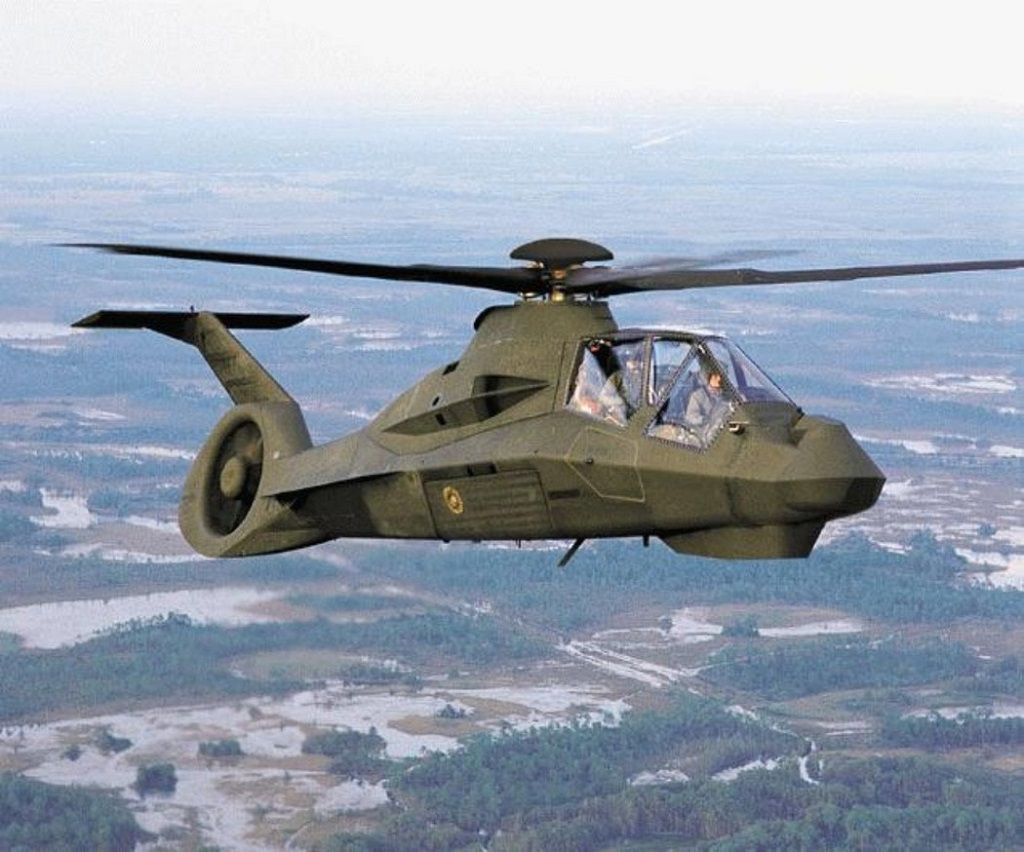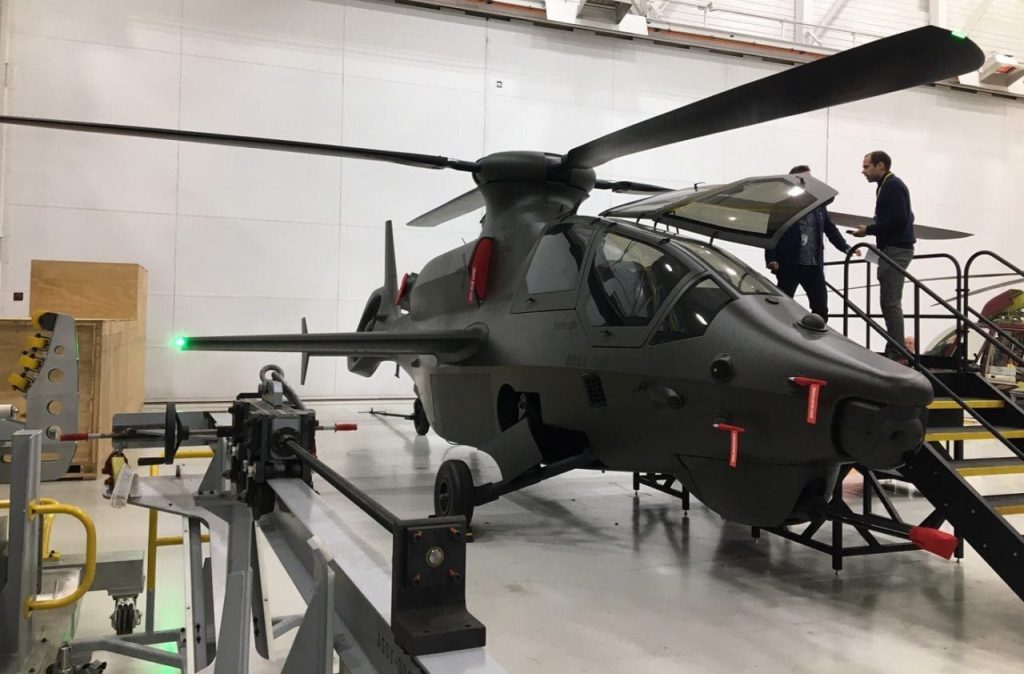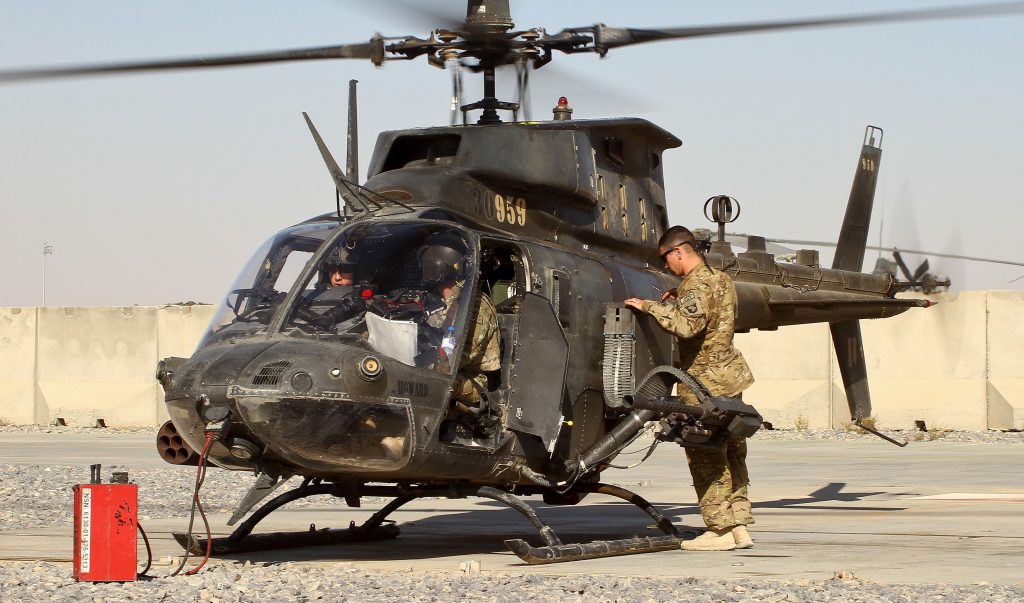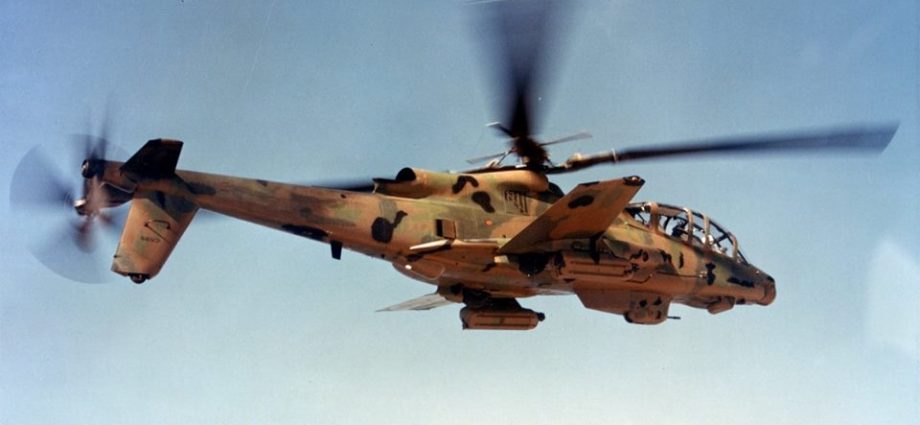Darren Olivier – Africa is characterised by asymmetric warfare which requires the larger, more technologically advanced combatant to be able to exercise dominance over small, convoluted and inaccessible places. These places may be dense urban environments such as cities or shack settlements, or remote jungles. This requires small, agile helicopters that can provide fast point to point intervention.

The most successful of these small agile helicopters has been the American OH-58D Kiowa Warrior, based on Bell’s ubiquitous 206A JetRanger. However, it is now largely obsolete – and the search for a replacement has thrown up two fascinatingly different approaches – and thus contenders.
It’s a sign of just how remarkable the OH-58D Kiowa Warrior was as an armed reconnaissance scout helicopter that the US Army has spent more than 20 years trying, and failing, to replace it with a slew of failed programmes.
First was the overly ambitious RAH-66 Comanche, a stealthy design meant to be able to fly deep into enemy territory well-defended by anti-aircraft systems. While impressive, the programme was killed in 2004 after $7 billion had been spent on it and numerous delays had made the in-service date increasingly uncertain.

Second was the ARA-70A Arapaho, which attempted to keep costs down by using an off-the-shelf commercial helicopter — the Bell 407 — and adapting it to carry the necessary sensors and weapons. It was a disaster, with development costs tripling compared to original plans and integration issues causing unacceptable delays. The Army pulled the plug on it at the end of 2008.
In 2013 Army planners tried again to launch a replacement programme, called the Armed Aerial Scout, but couldn’t get approval from the service’s leaders after it became clear that they still faced the same inherent inability to find a sweet spot between schedule, cost, and capability.
Eventually budget decisions forced the retirement of the OH-58D fleet without a direct replacement, with the Army moving AH-64D Apaches from the National Guard and Reserves into new Armed Reconnaissance Squadrons to take up the role previously carried out by the OH-58Ds. But experience has shown this to be a sub-optimal solution, with the AH-64s being too large and unwieldy for the scouting task, even when paired with MQ-1 Gray Eagle UAVs to extend their reach.
At the same time, experience gained from the years of hard operational use of the Army’s helicopters in Afghanistan and Iraq had begun to bear fruit in terms of new technologies developed as a result of lessons learned. And Russia’s invasion of Ukraine in 2014 caused a review of the Army’s aviation tactics and a recognition that even with UAVs there remained a need for a fast and agile armed reconnaissance helicopter able to fly at extreme low level both in the countryside and cities.
These coalesced into a broad new programme called Future Vertical Lift (FVL), which combines four interlinked projects:
1. Future Attack Reconnaissance Aircraft (FARA).
A new optionally-piloted 6-tonne lightweight armed reconnaissance helicopter, able to operate in confined spaces, cruise at 180 knots, dash at over 200 knots, and with a size and rotor diameter small enough to fly between buildings.
2. Future Long Range Assault Aircraft (FLRAA).
A replacement for the UH-60 Black Hawk, with requirements to carry 12 fully-equipped troops out to a distance of 2,440 nautical miles at a cruise speed of 280 knots.
3. Modular Open Systems Architecture (MOSA).
A standardised set of open standards and requirements for avionics and associated software, intended to avoid vendor lock-in and ensure that any supplier can offer modular components that can be integrated seamlessly onto the aircraft, or even provide line replaceable units (LRUs) that replace multiple discrete functions, without the need to redesign the controlling systems. Both FARA and FLRAA will also have separated digital buses for flight critical and mission-oriented systems, so that changes can be rolled out and tested rapidly without affecting the core flight critical controls.
4. Future Unmanned Aerial System (FUAS).
This includes:
A new long-range Advanced UAS (AUAS) to replace the Gray Eagle.
A shorter-ranged Future Tactical UAS (FTUAS) to replace the RQ-7 Shadow.
And most interestingly, Air Launched Effects (ALE), a set of tiny drones small enough to be launched from the FARA concept and designed to be everything from off-board decoys to electronic warfare jammers. Dozens of them can swarm intelligently and communicate using ad hoc mesh networks.
Long-range covert infiltration is now understood to be impossibly risky with modern air defence systems.
Along with this has come a fundamental rethink of the US Army’s approach to operating helicopters in attacks against highly defended enemies. Long-range covert infiltration, for which the RAH-66 Comanche was optimised, is now understood to be impossibly risky with modern air defence systems. Instead, the FARA will dart around the front lines, down city streets and around buildings while dispensing ALE drones to either conduct longer-ranged surveillance of key areas or to disrupt enemy defences and command and control networks. Heavy use will be made of various artificial intelligence (AI) approaches such as neural networks trained to identify the most high-threat targets, or the optimal order in which to take out enemy vehicles.

Unlike the old approach where OH-58Ds and AH-64Ds would be paired up in ‘hunter-killer’ combinations, the future FARA will be digitally linked to all friendly forces including troops on the ground, long-range artillery, AH-64Es, and so on, and able to pass on information or call in strikes from whichever is best placed to respond. For targets small enough to take out itself, the FARA will be armed with Spike NLOS missiles, the XM915 20mm cannon, and other weapons.
The basic concept is to move forces quickly, and launch precise yet powerful attacks on enemy positions all over the map
The basic concept is to use the ability of the future US Army to co-ordinate rapidly, move forces around quickly, and launch precise yet powerful attacks on enemy positions all over the map in order to disrupt the enemy’s air defence network badly enough to start to open up gaps and channels through which the FARA and FLRAA helicopters can make high-speed runs in order to further disrupt enemy systems, drop troops to take key locations, and expand the breach until it’s large enough for older generation aircraft like Apaches to come in and use their superior firepower to further turn the tide of battle.
Obviously, pulling this off puts extremely high demands on the FARA type, with it needing to be quiet, survivable enough to be on the front lines, small and nimble enough to dodge in and around buildings and city streets to avoid detection and being fired on, and yet still able to cruise at over 180 knots and have at least 200 knots dash speed.
In 2020 the US Army down-selected the FARA contenders to two options, one conventional and lower-risk and the other far more revolutionary in its approach. These will fly off against each other beginning in 2022, with a final selection to be made before 2028.
One is the Bell 360 Invictus, a conventional design with two crew in a tandem configuration, a single General Electric T901 engine, four-blade articulated rotor system, stub wings providing 50% of the lift at high speed, and a shrouded tail rotor. It’s based on Bell’s 525 Relentless civilian helicopter.
The other, arguably more interesting, competitor is the Sikorsky Raider X, a compound helicopter with two crew in a side-by-side configuration and a single GE T901 driving a coaxial counter-rotating rigid rotor system and a pusher propeller. Sikorsky claims that the Raider X’s max speed will be in excess of 250 knots, as a result of testing conducted on the basic design during the preceding S-97 Raider and X2 demonstrator projects.

Traditionally, helicopters have been prevented from reaching speeds of around 250 knots by retreating blade stall on the one hand and the risk of blade tips going supersonic on the other. The Raider X (and S-97 & X2) solve this problem through an ingenious mechanism that reduces the rotations per minute (rpm) of the main rotors down to around 85% of maximum. Not only does this reduce the onset of retreating blade stall and supersonic tip travel, but it reduces fuel used during cruise. The same technique can be used at low speeds too, in order to reduce the acoustic signature of the helicopter during scouting missions, when it can also switch off its pusher propeller to be even quieter.
It seems beyond doubt that the Raider X is the more impressive, and probably more capable, of the two contenders, but that is not what’s going to determine the winner of the FARA competition. If Bell can prove that its conventional 360 Invictus can meet the FARA requirements while offering low enough risk and cost, it’ll win the day against the faster and more technically-ambitious Raider X.
But whichever design wins, it’s clear that the Future Vertical Lift programme as a whole is bringing about a revolutionary set of changes in the way the US Army uses helicopters in combat. This is the way of the future: Integrated and mutually supporting high-technology systems with a high degree of manned/unmanned teaming, AI decision-making, mesh-based sensor networks, and a focus on rapid mobility and precision over brute force firepower.


